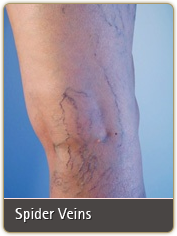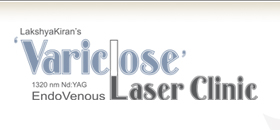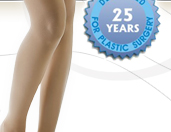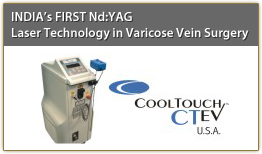| Spider Veins |
| |
| What are Spider Veins? |
| |
|
Spider veins, also medically known as telangiectasias or venulectasias, are the mildest manifestation of venous insufficiency, similar to varicose veins but smaller. They are tiny blood vessels closer to the surface of the skin than varicose veins and often look like tangled groups of blood vessels resembling spider webs or tree branches. They are generally red, blue or purple and are clearly visible, usually on the thighs, lower legs and face. Spider veins can sometimes cover large areas of skin, but they are only a cosmetic problem rarely causing physical symptoms. At least a third of all women and a smaller percentage of men are believed to have the condition.
Spider veins are thin walled capillaries directly connected with the larger venous system, and like varicose veins they are caused by venous reflux. Spider veins may be isolated or associated with feeder veins or with larger underlying varicose veins, but they are not varicose veins – they do not bulge above the skin surface and do not require medical treatment.
Spider vein treatments are considered cosmetic procedures and are not covered by health insurance, Medicare or Mediclaim unless a more serious underlying condition is diagnosed. |
 |
| |
| Spider Veins- How Do They Form? |
| Spider veins are thought to form due to genetic reasons. Women get them more than men and they develop after an age. Young people don’t suffer from this problem much. Spider veins can also be caused by the backup of blood. |
| |
| Spider Veins- What are the Risk Factors? |
| Spider veins are the mildest manifestation of venous reflux disease. Many of the risk factors for spider veins are similar to those for varicose veins – heredity, advancing age, pregnancy, obesity, hormonal changes and occupations requiring extended periods of standing. They can also be triggered by exposure to the ultraviolet rays of the sun, particularly in fair-skinned people, and by certain medications. Spider veins may also develop at the site of an injury to the skin surface, sometimes years after the injury. As with varicose veins, spider veins appear more often in women than in men. |
| |
| Spider Veins- Can they be prevented? |
| Some physicians believe that exercise, weight loss and the wearing of support hose or stockings and flat shoes instead of high heels can reduce the incidence of spider veins. |
| |
| Symptoms |
| Though spider veins rarely cause physical symptoms, they damage the skin beauty radically. Spider veins can form a painful blood clot with inflammation of the vein called thrombophlebitis. |
| |
| Diagnosis |
Spider veins can be diagnosed merely by sight. They tend to take on one of three characteristic patterns:
- Spider-Web or Sunburst: Radiating outward from a central point. They form a web like bundle that spreads from a center and that is why it is called spider veins.
- Matting or Tree-Branch: The small red and blue vein tangles are located just under the skin. They can look like tree branches with their short jagged lines.
- Linear pattern: This may be nothing more than a set of thin lines.
|
| |
| Test |
| Even in the absence of physical symptoms and discomfort, some physicians observing spider veins prefer to conduct an ultrasound exam to determine the extent of the problem and to find out whether there is an underlying cause for the condition. |
| |
| Treatments |
Spider veins can be treated using various methods depending on the location, width of the veins and severity of the problem. The only way to treat spider veins is to choke them up. They can be choked up in two ways: minimally invasive methods like radio frequency, sclerotherapy and non-invasive method like laser procedures.
These treatments are frequently and readily available in a doctor’s office. Both kinds of procedures are considered safe and allow the patient to return to normal activity immediately following vein treatment. |
| |
| Radio Frequency |
| By using a special hair like needle, which is covered by a fine layer of Teflon; except its tip, radio frequency energy is released inside the vein under magnification. The vein wall gets heated, blood clots and over next few days to weeks the vein just disappears. Body’s clearing mechanism called as ‘phagocytosis’ does this job of removing choked up and functionless segments of vein. |
| |
|
|








